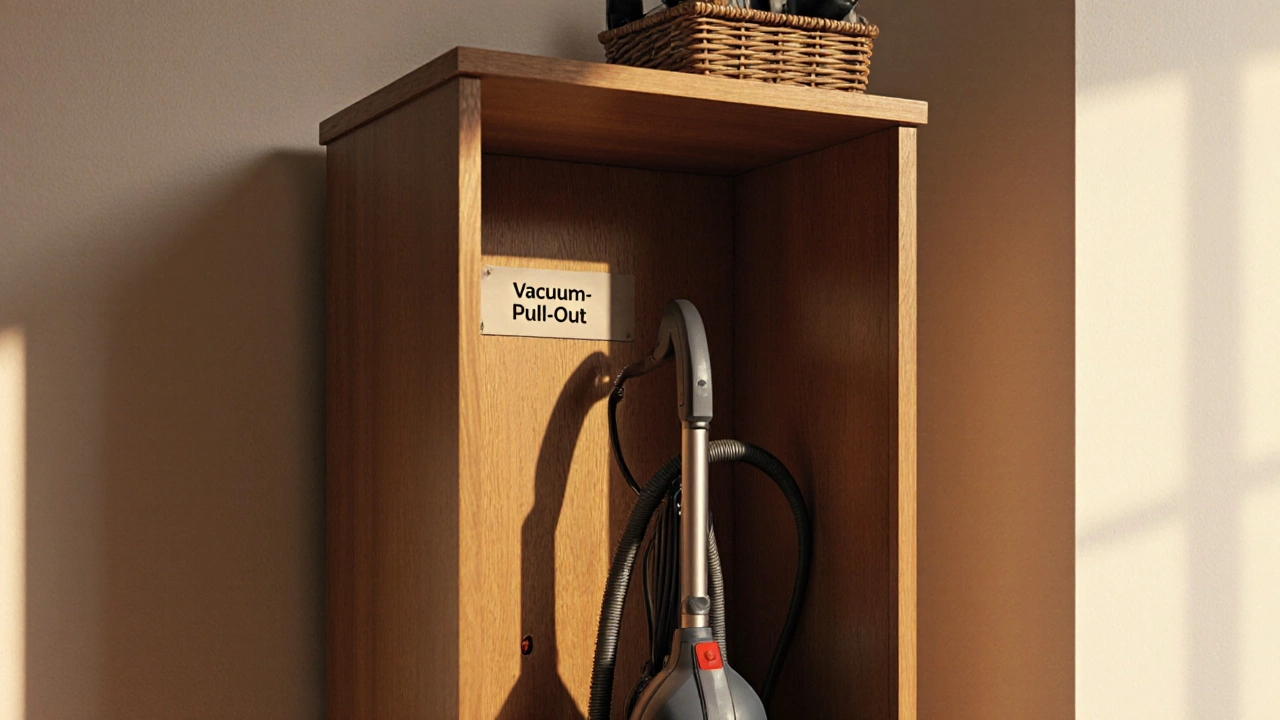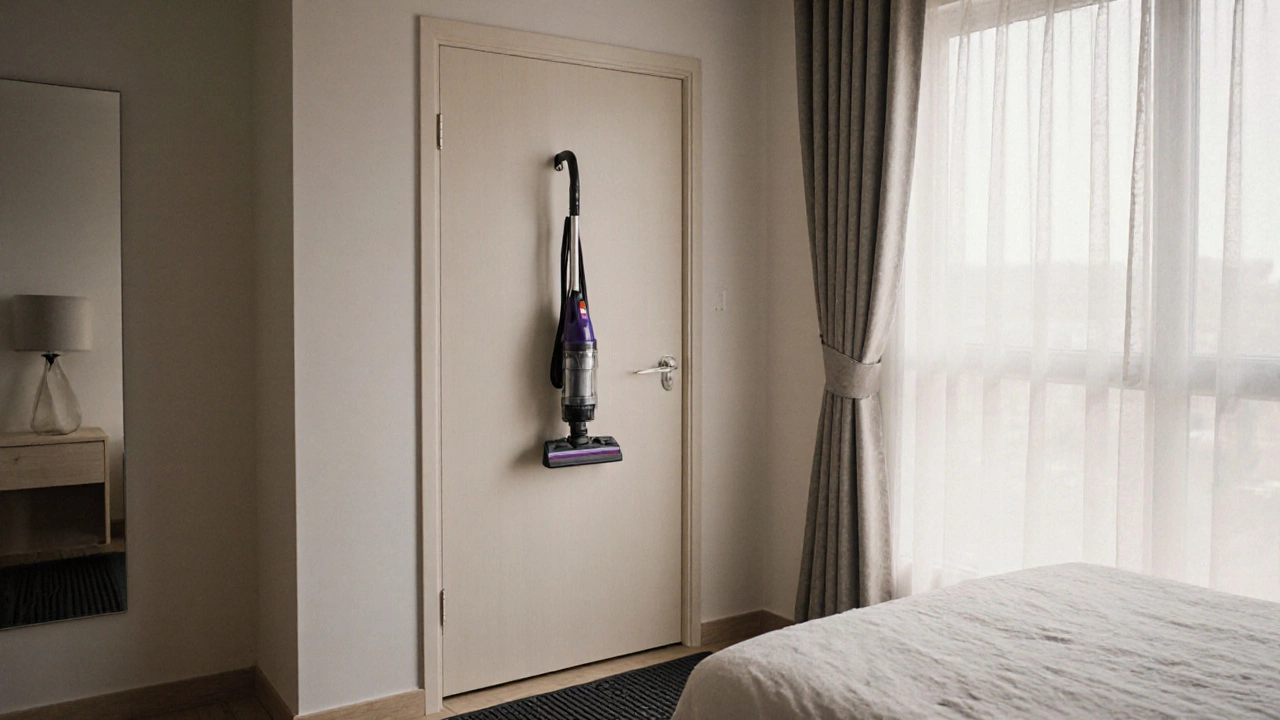Vacuum Storage Space Calculator
Calculate Your Best Storage Solution
Enter your home dimensions and vacuum type to get personalized recommendations from the article.
Your Recommended Solutions
If you live in a small apartment, a studio, or just don’t have a closet to spare, storing your vacuum cleaner can feel like a daily puzzle. You don’t want it blocking the hallway, leaning against the fridge, or taking up space where your shoes should go. The good news? You don’t need a closet to keep your vacuum out of sight and easy to reach. Here are 10 practical, space-smart ways to store your vacuum-no matter how tight your space is.
Use the Back of a Door
Most doors, even in tiny bathrooms or bedrooms, have unused vertical space. A simple over-the-door hook or a specialized vacuum storage rack can turn that blank space into a dedicated spot. Look for hooks rated for at least 15 kg-most upright vacuums weigh between 3 to 8 kg, but you’ll want room for attachments. Install it so the handle hangs down, and the body rests flat against the door. It’s invisible when the door’s closed, and you can grab it in one motion when you need it.
Hide It Under the Bed
If your bed has at least 20 cm of clearance underneath, this is one of the best hidden storage spots in the house. Slide your vacuum into a slim storage bin with wheels, or use a flat, low-profile vacuum bag designed for under-bed use. Stick a label on the front so you know what’s inside. This works especially well for cordless stick vacuums, which are narrow and lightweight. Just make sure you can still slide the vacuum in and out without scraping the floor or hitting the bed frame.
Mount It on the Wall
Wall mounting is the most space-efficient solution if you’re okay with a little DIY. Use a heavy-duty wall bracket designed for vacuums-many come with slots for the handle and a hook for the cord. Mount it near your main cleaning area: the kitchen, laundry, or entryway. Keep it at waist height so you don’t have to bend or reach too high. Some brackets even include a small shelf for extra attachments or a dusting brush. This keeps everything together and turns your vacuum into a built-in tool, not a clutter item.
Repurpose a Cabinet or Shelf
You don’t need a closet-you just need a cabinet. That unused cabinet above the washer and dryer? The one under the stairs? The shelf in your hallway? All of these can become vacuum homes. Line the bottom with rubber matting to prevent scratches, and keep a small basket inside for attachments. If the cabinet door sticks out too far, consider replacing it with a sliding door or removing it entirely. Open shelving with a decorative basket or bin in front looks intentional, not messy.
Store It in a Hallway Nook
Even in the tightest homes, there’s often a dead corner or a recessed area near the front door or between rooms. That’s your golden spot. Place a narrow console table or a tall, shallow storage unit there. Put your vacuum inside, upright, with the handle folded down. Add a small basket on top for gloves or lint rollers. This turns a wasted space into a functional cleaning station. Bonus: You’re already near the entrance, so you can grab it before heading to the living room or kitchen.

Use a Tall, Slim Storage Cabinet
Look for a cabinet that’s no wider than 30 cm but stands over 120 cm tall. These are often sold as linen cabinets, bookshelves, or narrow storage units. Place it against a wall in the kitchen, laundry, or even the bedroom. Slide your vacuum inside vertically. If it’s a corded model, route the cord neatly through a hole drilled in the back panel. Add a small label: “Vacuum-Pull Out.” This looks like intentional storage, not a last-minute fix.
Build a Hidden Panel
For those who want to go all-in on hidden storage: turn a section of your wall into a vacuum nook. Remove a small section of drywall (or use a pre-made wall cabinet insert) and install a hinged panel that matches your wall paint or wallpaper. Inside, mount a bracket for the vacuum. When closed, it looks like a regular wall. This is a mid-range DIY project, but it’s worth it if you hate seeing cleaning tools. Many homeowners in Perth use this trick in modern apartments where minimalist design matters.
Store It in the Garage or Utility Room
If you have a garage, laundry room, or even a balcony storage box, that’s your best bet. Keep the vacuum there with a small caddy for attachments and a power strip nearby for charging cordless models. Just make sure the area stays dry and isn’t too hot or cold-extreme temperatures can damage batteries and motors. Use a labeled bin to keep filters, brushes, and extension wands together. You’ll save indoor space and keep the vacuum out of the way.
Go Cordless and Keep It on a Charging Stand
Cordless stick vacuums changed the game. Many come with wall-mounted charging docks that also act as storage. Mount it on the wall near your kitchen or laundry area. The vacuum snaps in, charges, and stays upright. No cords to tangle, no clutter. Brands like Dyson, Shark, and LG make models with sleek, modern docks that look like decor, not gadgets. If your vacuum doesn’t come with one, buy a universal charging stand-it’s under $30 and works with most stick vacuums.

Use Furniture with Built-In Storage
Some modern furniture is designed with hidden compartments. Look for ottomans with lift-top lids, benches with drawers, or side tables with hollow bases. Choose one that’s sturdy enough to hold the weight of your vacuum. Place it in the living room or entryway. You can even use a decorative basket inside to hide the vacuum and keep it from rattling. This turns storage into style. Bonus: You get extra seating or surface space too.
Pro Tips for Long-Term Storage
Where you store it matters, but how you store it matters more. Always empty the dustbin after every use-wet debris can cause odors and damage filters. Remove and clean the filter monthly. Store the vacuum upright, never on its side, to avoid damaging the brush roll. If you have pets, keep a small brush handy to clean hair off the roller before putting it away. And never leave a corded vacuum plugged in when not in use-it’s a fire risk.
What to Avoid
Don’t store your vacuum under heavy items-it can crush the body or damage the wheels. Don’t leave it in direct sunlight-UV rays degrade plastic and rubber parts. Don’t pile clothes or boxes on top of it. And don’t ignore the cord. Wrap it neatly around the handle or use a cord organizer. A tangled cord is the #1 reason people avoid cleaning in the first place.
Final Thought: Make It Invisible
The goal isn’t just to hide your vacuum-it’s to make cleaning effortless. When your vacuum is easy to grab, you’ll use it more. When it’s out of sight, your space feels calmer. Pick the method that fits your home’s layout, not your ideal vision. A hook on the back of a door works better than a fancy cabinet if you’re short on time. The best storage solution is the one you actually use.
Can I store my vacuum in the garage?
Yes, if the garage is dry and not too hot or cold. Extreme temperatures can damage batteries in cordless models and weaken plastic parts. Keep the vacuum off the floor and in a labeled bin with attachments. Avoid leaving it near chemicals or gasoline.
What’s the best vacuum storage for small apartments?
Wall mounting or under-bed storage works best. Wall brackets save floor space and keep everything visible and accessible. Under-bed storage is ideal if you have clearance and want total concealment. Cordless stick vacuums with charging docks are perfect for tight spaces.
Should I unplug my vacuum when not in use?
Always unplug corded vacuums when not in use. Even when turned off, they can overheat or cause electrical faults if damaged. Cordless models are safer since they’re battery-powered, but remove them from the charger once fully charged to extend battery life.
Can I store a vacuum vertically?
Yes, and it’s actually recommended. Storing upright prevents the brush roll from becoming misshapen and reduces stress on the wheels and motor. Use a wall bracket, floor stand, or tall cabinet that holds it upright. Never store it on its side or upside down.
How do I hide a corded vacuum without a closet?
Use a narrow cabinet or tall storage unit with a door. Route the cord through a small hole in the back and coil it neatly inside. Mount a hook on the inside to hang the handle. Add a label so you know what’s inside. This keeps the cord out of sight and prevents tangling.
